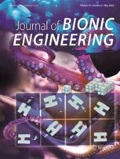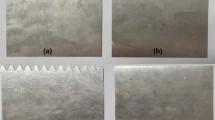Abstract
The Leading-Edge (LE) serrations on owls’ wings are known to be responsible for silent flight. However, this design has rarely been applied to reduce the noise of rotational rotor propellers and the morphologies of the existing serration designs are diverse. Here, we present a comparative study of LE serrations with different morphologies in terms of the effectiveness in suppressing noise and promoting thrust forces. The performances of biomimetic propellers are investigated by Computational Fluid Dynamics (CFD) simulations and rotation experiments. The simulation results reveal that LE serrations could reduce velocity fluctuations and change the lamina-turbulent transition and turbulence distribution on the suction surface of propeller, but the morphology of the serrations influences its effectiveness. Rotation testing results indicate that the sawtooth propeller has the best performance on noise reduction (on average 2.43 dB and in maximum 4.18 dB) and simultaneously enhancing the thrust forces (3.53%). The largest practical noise reductions (4.73 dB and 3.79 dB) using the sawtooth propeller are observed when the quad-rotor Unmanned-Aerial Vehicle (UAV) is hovering at heights of 5 m and 8 m, respectively. Our results indicate the robustness and usefulness of owl-inspired biomimetic serration devices for aero-acoustic control and aerodynamic performance promotion on propeller designs. This finding is expected to contribute to suppressing the sound of propeller and the rotor-based aircraft.
Similar content being viewed by others
References
Graham R R. The silent flight of owls. Journal of the Royal Aeronautical Society, 1934, 38, 837–843.
Ge C J, Ren L Q, Liang P, Zhang C C, Zhang Z H. High-lift effect of bionic slat based on owl wing. Journal of Bionic Engineering, 2013, 10, 456–463.
Gruschka H D, Borchers I U, Coble J G. Aerodynamic noise produced by a gliding owl. Nature, 1971, 233, 409–411.
Bachmann T, Blazek T S, Erlinghagen T, Baumgartner W, Wagner H. Barn owl flight. Notes on Numerical Fluid Mechanics & Multidisciplinary Design, 2012, 119, 101–117.
Chen K, Liu Q P, Liao G H, Yang Y, Ren L Q, Yang H X, Chen X. The sound suppression characteristics of wing feather of owl (Bubo bubo). Journal of Bionic Engineering, 2012, 9, 192–199.
Lilley G M. A study of the silent flight of the owl. 4th AIAACEAS Aeroacoustics Conference, Toulouse, France, 1998, 1–6.
Sarradj E, Fritzsche C, Geyer T. Silent owl flight: Bird flyover noise measurements. AIAA Journal, 2011, 49, 769–779.
Wagner H, Weger M, Klaas M, Schröder W. Features of owl wings that promote silent flight. Interface Focus, 2017, 7, 1–11.
Geyer T, Claus V T, Sarradj E. Silent owl flight: The effect of the leading edge comb on the gliding flight noise. 22nd AIAACEAS Aeroacoustics Conference, Lyon, France, 2016, 1–12.
Bachmann T, Wagner H. The three-dimensional shape of serrations at barn owl wings: Towards a typical natural serration as a role model for biomimetic applications. Journal of Anatomy, 2011, 219, 192–202.
Ito S. Aerodynamic influence of leading-edge serrations on an airfoil in a low Reynolds number: A study of an owl wing with leading edge serrations. Journal of Biomechanical Science and Engineering, 2009, 4, 117–122.
Klän S, Klaas M, Schröder W. The influence of leading edge serrations on the flow field of an artificial owl wing. 28th AIAA Applied Aerodynamics Conference, Chicago, USA, 2010, 1–9.
Jaworski J W, Peake N. Parametric guidance for turbulent noise reduction from poroelastic trailing edges and owls. 19th AIAACEAS Aeroacoustics Conference, Berlin, Germany, 2007, 1–14.
Clark I A, Alexander W N, Devenport W, Glegg S, Jaworski J W, Daly C, Peake N. Bioinspired trailing-edge noise control. 21st AIAA/CEAS Aeroacoustics Conference, Dallas, USA, 2015, 1–18.
Klän S, Burgmann S, Bachmann T, Klaas M, Wagner H, Schröder W. Surface structure and dimensional effects on the aerodynamics of an owl-based wing model. European Journal of Mechanics-B/Fluids, 2012, 33, 58–73.
Winzen A, Klaas M, Schröder W. High-speed PIV measurements of the near-wall flow field over hairy surfaces. Experiments in Fluids, 2013, 54, 1472–1486.
Kim J W, Haeri S, Joseph P F. On the reduction of aerofoil-turbulence interaction noise associated with wavy leading edges. Journal of Fluid Mechanics, 2016, 792, 526–552.
Zhong S Y, Zhang X, Gill J, Fattah R, Sun Y H. A numerical investigation of the airfoil-gust interaction noise in transonic flows: Acoustic processes. Journal of Sound & Vibration, 2018, 425, 239–256.
Koch U R, Wagner H. Morphometry of auricular feathers of barn owls (Tyto alba). European Journal of Morphology, 2002, 40, 1–15.
Weger M, Wagner H. Morphological variations of leading-edge serrations in owls (Strigiformes). PLoS One, 2016, 11, 1–21.
Winzen A, Roidl B, Klän S, Klaas M, Schröder W. Particle-image velocimetry and force measurements of leading-edge serrations on owl-based wing models. Journal of Bionic Engineering, 2014, 11, 423–438.
Winzen A, Roidl B, Schröder W. Particle-image velocimetry investigation of the fluid-structure interaction mechanisms of a natural owl wing. Bioinspiration & Biomimetics, 2015, 10, 423–438.
Huang X. Theoretical model of acoustic scattering from a flat plate with serrations. Journal of Fluid Mechanics, 2017, 819, 228–257.
Rao C, Ikeda T, Nakata T, Liu H. Owl-inspired leading-edge serrations play a crucial role in aerodynamic force production and sound suppression. Bioinspiration & Biomimetics, 2017, 12, 1–13.
Rao C, Liu H. Aerodynamic robustness in owl-inspired leading-edge serrations: A computational wind-gust model. Bioinspiration & Biomimetics, 2018, 13, 056002.
Ikeda T, Ueda T, Nakata T, Noda R, Tanaka H, Fujii T, Liu H. Morphology effects of leading-edge serrations on aerodynamic force production: An integrated study using PIV and force measurements. Journal of Bionic Engineering, 2018, 15, 661–672.
Wang Z Y, Zhuang M. Leading-edge serrations for performance improvement on a vertical-axis wind turbine at low tip-speed-ratios. Applied Energy, 2017, 208, 1184–1197.
Tong F, Qiao W Y, Xu K B, Wang L F, Chen W J, Wang X N. On the study of wavy leading-edge vanes to achieve low fan interaction noise. Journal of Sound and Vibration, 2018, 419, 200–226.
Geyer T, Wasala S H, Cater J E, Norris S E, Sarradj E. Experimental investigation of leading edge hook structures for wind turbine noise reduction. 22nd AIAA/CEAS Aeroacoustics Conference, Lyon, France, 2016, 1–13.
Juknevicius A, Chong T P. On the leading edge noise and aerodynamics of thin aerofoil subjected to the straight and curved serrations. Journal of Sound and Vibration, 2018, 425, 324–343.
Chen W J, Qiao W Y, Wang X, Tong F, Wang X N, Wang L F. Numerical investigation of wavy leading edges on rod-airfoil interaction noise. AIAA Journal, 2018, 56, 1–15.
Aguilera F G, Gill J R, Angland D, Zhang X. Wavy leading edge airfoils interacting with anisotropic turbulence. 23rd AIAA/CEAS Aeroacoustics Conference, Denver, USA, 2017, 1–16.
Lyu B, Azarpeyvand M. On the noise prediction for serrated leading edges. Journal of Fluid Mechanics, 2017, 826, 205–234.
Narayanan S, Chaitanya P, Haeri S, Joseph P, Kim J W, Polacsek C. Airfoil noise reductions through leading edge serrations. Physics of Fluids, 2015, 27, 1–17.
Chaitanya P, Narayanan S, Joseph P, Kim J W. Leading edge serration geometries for significantly enhanced leading edge noise reductions. 22nd AIAA/CEAS Aeroacoustics Conference, Lyon, France, 2016, 1–19.
Menter F R. Zonal two equation k-w turbulence models for aerodynamic flows. 23rd Fluid Dynamics, Plasmadynamics, and Lasers Conference, Orlando, USA, 1993, DOI: https://doi.org/10.2514/6.1993-2906.
Menter F R. Two-equation eddy-viscosity turbulence models for engineering applications. AIAA Journal, 1994, 32, 1598–1605.
Acknowledgment
This research was supported by the National Natural Science Foundation of China (No. 11774355). Special thanks are extended to the Wildlife Park, Hefei, Anhui, China for providing the feathers of owls and hawks.
Author information
Authors and Affiliations
Corresponding author
Rights and permissions
About this article
Cite this article
Wei, Y., Xu, F., Bian, S. et al. Noise Reduction of UAV Using Biomimetic Propellers with Varied Morphologies Leading-edge Serration. J Bionic Eng 17, 767–779 (2020). https://doi.org/10.1007/s42235-020-0054-z
Published:
Issue Date:
DOI: https://doi.org/10.1007/s42235-020-0054-z




